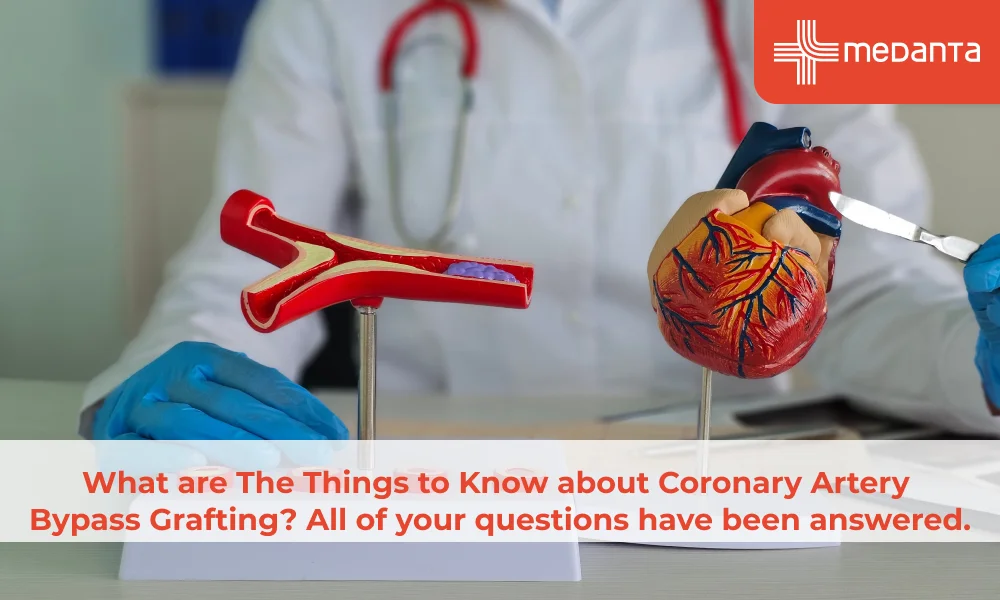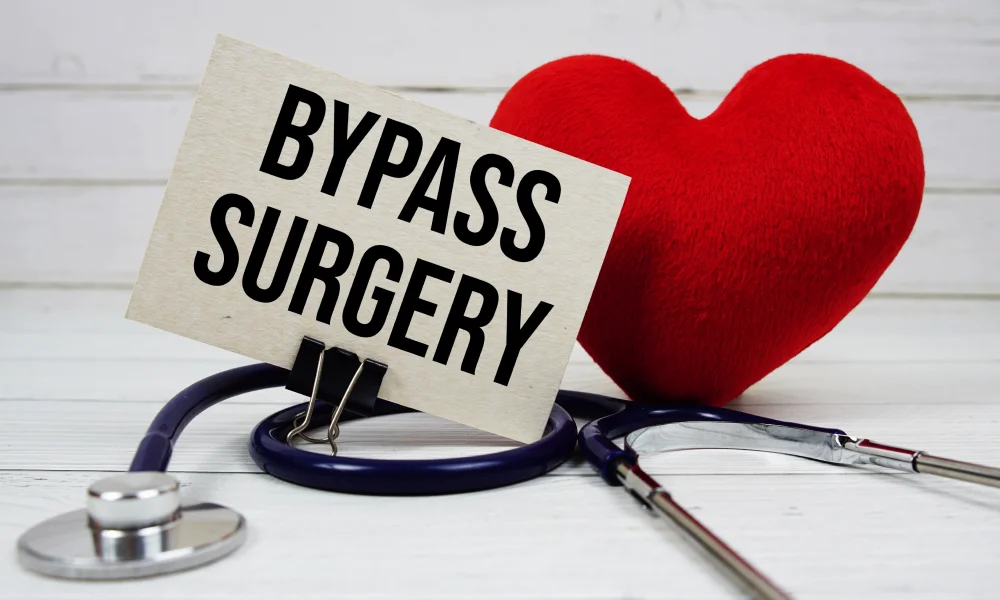What are The Things to Know about Coronary Artery Bypass Grafting? All of your questions have been answered.

TABLE OF CONTENTS
Overview: What Is CABG Surgery?
Coronary Artery Bypass Grafting surgery is also known by its initials CABG and pronounced as "cabbage." CABG surgery is done when the coronary arteries that supply blood to the heart muscles are blocked. During coronary artery bypass surgery, your surgeon will use a healthy blood vessel from another part of your body to create an alternate route or bypass, the narrowed or blocked sections of your coronary arteries. This bypass allows required blood flow to reach your heart muscle so that heart can pump normally. The healthy blood vessel used to bypass the diseased coronary artery can be taken from within chest wall (mammary arteries) from arms (radial arteries) or from legs (saphenous veins).
Venous CABG: all the by-pass grafts are venous i.e. taken from legs.
Mixed CABG: atleast one arterial conduit and remaining venous conduits are used for bypass.
Total arterial CABG: only arterial grafts (mammary arteries, radial arteries or gastroepiploic arteries) are used to bypass all targets.
The new blood vessel is called a graft. The number of grafts in the surgery depends on the severity of coronary artery disease (we have three coronary arteries supplying out heart muscle) and the number of diseased coronary arteries. (Single vessel, double vessel or triple vessel disease). The Bypass surgery is done under general anesthesia which means patient remains unaware of the proceedings as he is made to sleep by medicine.
How Is The Surgery Performed?
An incision of about 6 to 8 inches is made in the center of the chest to expose your heart and blocked arteries. Conduits are harvested from legs, arms and chest wall accordingly. Healthy conduits are sewn to blocked arteries in a fashion to reestablish blood flow to that region. `Traditionally a heart lung machine is used while doing this operation in a still heart and the heart-lung machine then performs the pumping and oxygenating functions of heart and lung. In a beating heart CABG, bypass surgery is performed while the heart is beating and doing its normal function and heart lung machine is not used. Minimally invasive CABG is done thru a small incision in the chest cavity without cutting the breast bone.
Conventional CABG is where surgeon uses atleast one arterial conduit and remaining two or more venous conduit to bypass all dseasd arteries either in beating or arrested heart.
TAR Bypass: surgeons use only arterial conduits (total arterial revascularization).

Why Is Bypass Surgery Performed?
Our heart is a muscular pump which works continuously without taking any rest for which it requires uninterrupted supply of blood for its energy. The three coronary arteries which are attached to three walls of the muscular chamber, supply blood to heart muscle continuously. Whenever there is significant blockage (more than 70%) to any coronary artery, there will be demand supply mismatch and that particular muscle area will not contribute to pumping action properly (ischemia) or even muscle can die (infarction) which is heart attack. A person can succumb to major heart attack before reaching to hospital and if he survives his heart’s pumping function may get reduced leading to heart failure.
Coronary artery disease can be presented as,
Angina pectoris (Chest pain radiating to left arm), Heart burn (like acidity), heaviness in chest on walking, uneasiness or chest heaviness after meal, difficulty in breathing, ghabrahat, sweating, palpitations, fatigue, unconsciousness sometimes even sudden death.
The main purpose of performing a CABG operation is
Improve quality of life by alleviating all symptoms of coronary artery disease
Improve quantity of life: by preventing major heart attack and its complications.(reducing morbidity and mortality)
Management strategy for Coronary artery disease are 1.Optimal medical management, 2.Catheter guided therapy (PTCA) 3.Coronary artery bypass surgery (CABG).
Coronary artery bypass grafting (CABG) is the one of the most effective revascularization strategies for patients with obstructive coronary artery disease as it A. relieves symptoms and improves survival.
Conventional CABG Vs TAR
Over 1 million CABG performed worldwide each year; standard operation involves CABG x 3 (1 internal thoracic artery (ITA) and 2 vein grafts).Strong angiographic evidence of increasing failure of vein grafts over time (due to progressive atherosclerosis) that accelerates after 10 years and that increases overall mortality and cardiac morbidity. On the contrary, evidence suggest that mammary artery grafts have excellent long term patency rates (> 90% at 20 years).Left mammary artery is established as the standard of care for grafting the left anterior descending (LAD) coronary artery during CABG. Numerous observational studies have estimated a 20% reduction in mortality with Bilateral versus Single ITA grafts over the long-term.
LIMA to LAD grafting is shown to remain patent more than 20 yrs and offers survival benefit. But venous conduit starts failing over years due to intimal hypertrophy and atherosclerosis. To overcome this shortcoming, many surgeons started using all arterial conduits like internal mammary artery, radial artery, gastroepiploic artery etc.
Total arterial CABG offers many benefits over conventional CABG
Excellent long term patency(>25 yrs) in comparison to saphenous vein graft which in 60% cases starts failing in about 10yrs.
No touch to aorta, no clamp, and no holes so less chances of Cerebrovascular accident.
No cuts in legs or hands for conduits, less morbidity.
Incidence of MACE (Major adverse cardiac events): Stroke, myocardial infarction, hospitalization for heart failure, coronary revascularization, and death is lower compared to conventional surgery.
No Cardiopulmonary bypass related complications, early extubation and fast track course.
Undergoing a Bypass Surgery Make Sure You Choose the Right Hospital?
Medanta Hospitals has a world-renowned team of heart specialists who offers comprehensive cardiac care under one roof with compassion. With state-of-the-art surgical treatments, research, and laboratory facilities, Medanta experts use advanced technology and sophisticated imaging tests for accurate diagnosis and post- operative rehabilitation.
Conclusion
Coronary artery bypass surgery (CABG) remains one of the best strategies for treating coronary artery disease (blockage in heart vessel) and superior option for multi vessel severe disease. Total Arterial Bypass surgery using both internal mammary arteries (BIMA Bypass) offers excellent long term disease free survival. BIMA bypass offers long term survival, less chances of stroke and further requirement of repeat intervention.. Major adverse cardiac events (MACE) like heart attack, stroke, hospitalization, repeat procedure and death are less following bypass surgery than angioplasty.. SYNTAX, FAME 3 and many more trials suggest CABG is highly effective for symptoms and prognosis in multivessel coronary artery disease and remains gold standard therapy.
Coronary artery bypass graft surgery is the most widely used surgical treatment to treat coronary artery disease. After this procedure, the patient does not suffer from any symptoms for more than 15-20 yrs. However, patients may experience recurrence of clogged arteries if their lifestyle habits are unhealthy, so you should maintain a healthy and active lifestyle after surgery. Some important lifestyle guidelines to follow here are: Follow a healthy and balanced lifestyle, avoid smoking, do exercise regularly and avoid stress, control blood pressure,diabetes and timely medical follow-up and advice.



